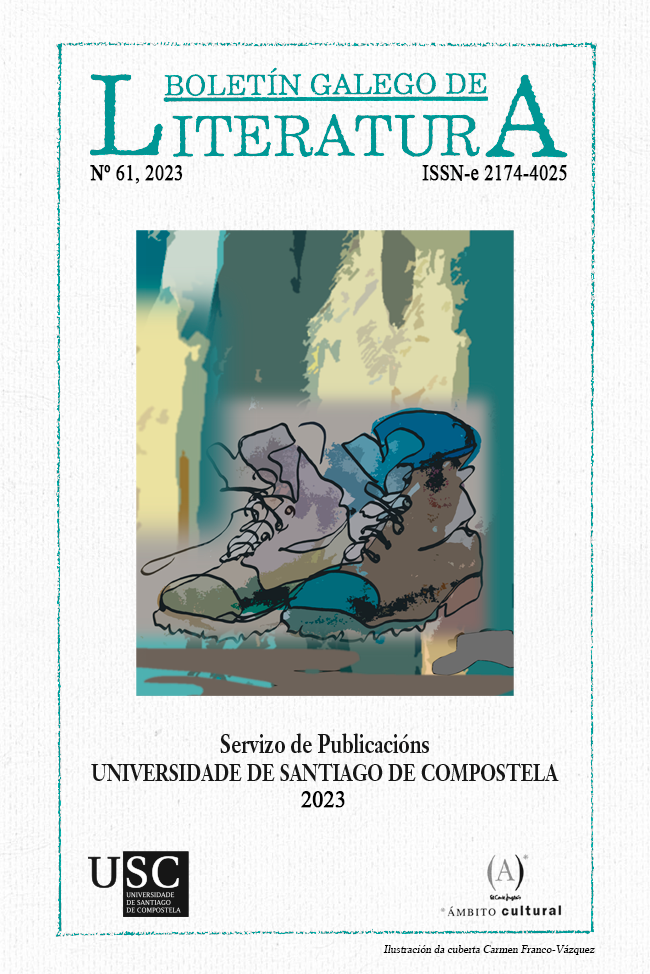A representación do dragón na Literatura Infantil e Xuvenil galega do século XX
Contido principal do artigo
Resumo
Realízase un breve achegamento teórico sobre a figura do dragón (características físicas, funcións e papel actancial) na literatura de transmisión oral e sobre o seu aproveitamento na Literatura Infantil e Xuvenil. Logo, coméntanse obras deste sistema literario publicadas no século XX que empregan este personaxe. Analízase a súa aparencia, o papel na trama e a adaptación realizada polos escritores, facendo uso da modernización, humanización, deconstrución, caricaturización etc. Obsérvase a súa evolución ao longo dos tempos e conclúese que maiormente se mantén a esfera de acción de agresor ou gardián de tesouros e o aspecto físico; e, en menor medida, modifícase o rol e prosopografía, ben polo efecto da humanización ou pola caricatura, humor ou parodia.
Palabras chave
Detalles do artigo
Citas
Aarne-Thompson, A. (1971). The Types of the folktale. A classifi cation and bibliography. Burt Franklin.
Agrelo, E. (2013). Entre princesas e dragóns. El Correo Gallego, 42.
Chevalier, J. (1986). Diccionario de los símbolos. Editorial Herder.
Fernández, Mª J. (2000). Xaquín Marín Formoso. Dragón Rock. Fadamorgana, 4, 76.
Fernández, Mª J. (2014). Voces de mujer. Peonza, 108, 31-37.
Fernández Paz, A. (1999). Literatura infantil e xuvenil. Revista Galega do Ensino, 25, 193-201.
Ferreira, Mª del C. (2022). As reescrituras de contos marabillosos na Literatura Infantil e Xuvenil galega (das orixes a 2010). Hércules de Ediciones.
González, M. (Dir.) (2023). Dicionario da Real Academia Galega. Real Academia Galega. https://academia.gal/dicionario
Martos, E. e Martos, A. (2012). Imaginarios del “Devoramiento” en la cultura del agua: Dragones, “Tragantía”, Tragaldabas y otros espantos. Implicaciones didácticas. Indivisa, 13, 122-143.
Noia, C. (2002). Contos galegos de tradición oral. Edicións NigraTrea.
Propp, V. (1928, 2006). Morfologija skazky. Leningrado: Nauka/ Trad. Lourdes Ortiz. Morfología del cuento. Editorial Fundamentos.
Propp, V. (1974). Las raíces históricas del cuento. Fundamentos.
Ramos, R. A. (1988). El cuento folclórico: una aproximación a su estudio. Editorial Pliegos.
Roig, B.-A. (1996). A Literatura Galega Infantil: Perspectiva diacrónica, descrición e análise da actualidade. Servicio de Publicacións e Intercambio Científico.
Roig, B. A. (Coord.) (2015). Historia da Literatura Infantil e Xuvenil Galega. Edicións Xerais de Galicia.
Rubio, P. (1982). Estructuras en cuentos populares castellanos. (Propuesta de un método de trabajo). Universidad de Valladolid.
Sánchez, L. (1998). Las mil caras del dragón. CLIJ. Cuadernos de Literatura Infantil y Juvenil, 103, 7-15.
Valriu, C. (1998). Influències de les rondalles en la literatura infantil i juvenil catalana actual (1975-1985). Editorial Moll.
Valriu, C. (2010). Reescriptures de les rondalles en el s. XXI (2000-2009). En B. A. Roig, M. Neira e I. Soto (Coords.), Reescrituras do conto popular (2000-2009) (pp. 13-30). Edicións Xerais de Galicia.
Artigos máis lidos do mesmo autor/a(s)
- Blanca Ana Roig Rechou, Eulalia Agrelo Costas, Mar Fernández Vázquez, Carmen Ferreira Boo, Isabel Mociño González, Marta Neira Rodríguez, Verónica Pousada Pardo, Guía de narrativa. Prelectores e primeiros lectores , Elos: Revista de Literatura Infantil e Xuvenil: No 3 (2016)
- Blanca-Ana Roig Rechou, Eulalia Agrelo Costas, Berta Dávila Fernández, Carmen Ferreira Boo, Marta Neira Rodríguez, Guía de poesía. De 3 a 8 anos , Elos: Revista de Literatura Infantil e Xuvenil: No 1 (2014)
- Carmen Ferreira Boo, Aproximações ao livro-objeto: das potencialidades creativas às propostas de leitura , Elos: Revista de Literatura Infantil e Xuvenil: No 5 (2018)
- Carmen Ferreira Boo, Elos. Revista de Literatura Infantil e Xuvenil, nº 5 , Boletín Galego de Literatura: No 56 (2020): 1º semestre
- Carmen Ferreira Boo, Conto marabilloso e reescritas na Literatura Infantil e Xuvenil Galega , Elos: Revista de Literatura Infantil e Xuvenil: No 7 (2020)
- Carmen Ferreira Boo, Manipulación física e lectura: os libros artesanais de Cintia Martín , Elos: Revista de Literatura Infantil e Xuvenil: No 9 (2022)
- Carmen Ferreira Boo, Fina Casalderrey, exemplo de mestra e escritora a prol da educación literaria, o fomento de valores e a Literatura Infantil e Xuvenil , Elos: Revista de Literatura Infantil e Xuvenil: No 10 (2023)







